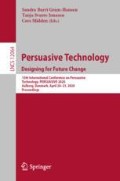Abstract
Phishing has become a major security threat in this Internet age. Dubious computer geeks and malicious hackers tend to make use of this mode of cyberattack due to the ability of phishes to deceive unsuspecting users without being prevented by various system security measures. The major reason why people fall for phishing attacks is that they are mostly unaware of how to detect them. This paper presents the design and implementation of a mobile persuasive game for promoting online security by teaching people how to detect and avoid phishing links. We also present the results and insights from the playability and persuasiveness evaluation of the game. The evaluators reported an overall high level of playability according to the Heuristic Evaluation for Playability (HEP). Above all, the results show that the game is highly persuasive, hence is expected to effectively motivate the desired behaviour of promoting online security. Based on our results, we provided some design consideration and insights from the evaluators’ comments.
Access this chapter
Tax calculation will be finalised at checkout
Purchases are for personal use only
References
Brinol, P., et al.: Ease and persuasion: multiple processes, meanings, and effects (2013)
Brown, S.J., et al.: Educational video game for juvenile diabetes: results of a controlled trial. Med. Inform. (1997). https://doi.org/10.3109/14639239709089835
Chen, Y.-X., et al.: Opportunities for persuasive technology to motivate heavy computer users for stretching exercise. In: Spagnolli, A., Chittaro, L., Gamberini, L. (eds.) PERSUASIVE 2014. LNCS (LNAI), vol. 8462, pp. 25–30. Springer, Cham (2014). https://doi.org/10.1007/978-3-319-07127-5_3
Chittaro, L., Sioni, R.: Turning the classic snake mobile game into a location–based exergame that encourages walking. In: Bang, M., Ragnemalm, E.L. (eds.) PERSUASIVE 2012. LNCS, vol. 7284, pp. 43–54. Springer, Heidelberg (2012). https://doi.org/10.1007/978-3-642-31037-9_4
CISCO: Cyber Attack - What Are Common Cyberthreats? – Cisco. https://www.cisco.com/c/en/us/products/security/common-cyberattacks.html#~types-of-cyber-attacks. Accessed 31 Oct 2019
Desurvire, H., et al.: Using heuristics to evaluate the playability of games. In: Extended Abstracts of the 2004 Conference on Human Factors and Computing Systems - CHI 2004 (2004). https://doi.org/10.1145/985921.986102
Dickinson, A., et al.: UKKO: enriching persuasive location based games with environmental sensor data. In: CHI PLAY 2015 Proceedings of the 2015 Annual Symposium on Computer-Human Interaction in Play (2015). https://doi.org/10.1145/2793107.2810324
Dreamy Dingo: Matching games Memory games Pairs: Remembery. https://play.google.com/store/apps/details?id=ua.krou.remembery&hl=en. Accessed 21 Oct 2019
Fogg, B.: Creating persuasive technologies: an eight-step design process. In: Proceedings of the 4th International Conference on Persuasive Technology – Persuasive 2009 (2009). https://doi.org/10.1145/1541948.1542005
Webroot Inc.: Nearly 1.5 Million New Phishing Sites Created Each Month | Webroot. https://www.webroot.com/us/en/about/press-room/releases/nearly-15-million-new-phishing-sites. Accessed 01 Nov 2019
Jagatic, T.N., et al.: Social phishing. Commun. ACM (2007). https://doi.org/10.1145/1290958.1290968
Jakobsson, M.: The human factor in phishing. Priv. Secur. Consum. Inf. (2007). https://cofense.com/wp-content/uploads/2017/11/Enterprise-Phishing-Resiliency-and-Defense-Report-2017.pdf
Kadomura, A., et al.: Sensing fork and persuasive game for improving eating behavior (2013). https://doi.org/10.1145/2494091.2494112
Kumaraguru, P., et al.: School of phish: a real-world evaluation of anti-phishing training categories and subject descriptors. In: Proceedings of the 5th Symposium Usable Privacy Security - SOUPS 2009, p. 12 (2009). https://doi.org/10.1145/1572532.1572536
Lin, T., et al.: A persuasive game to encourage healthy dietary behaviors of kindergarten children. In: Adjunct Proceedings of the 8th International Conference on Ubiquitous Computing (2006)
Magma Mobile: MatchUp: Exercise your Memory. https://play.google.com/store/apps/details?id=com.magmamobile.game.MatchUp&hl=en. Accessed 12 Oct 2019
Misra, G., et al.: Phish phinder: a game design approach to enhance user confidence in mitigating phishing attacks (2017)
Ndulue, C., Orji, R.: STD PONG: an African-centric persuasive game for risky sexual. In: Adjunct Proceedings of the Persuasive Technology Conference (2018)
Nielsen, J., Molich, R.: Heuristic evaluation of user interfaces. In: CHI 1990 Proceedings of the SIGCHI Conference on Human Factors in Computing System (1990). https://doi.org/10.1145/97243.97281
Oinas-Kukkonen, H., Harjumaa, M.: Persuasive systems design: key issues, process model, and system features. Commun. Assoc. Inf. Syst. 24(1), 485–500 (2009)
Orji, R., et al.: LunchTime: a slow-casual game for long-term dietary behavior change. Pers. Ubiquit. Comput. 17(6), 1211–1221 (2013). https://doi.org/10.1007/s00779-012-0590-6
PhishFindR: Phishing Database. https://github.com/mitchellkrogza/Phishing.Database. Accessed 30 Sept 2019
PhishMe Inc.: Analysis of Susceptibility, Resiliency and Defense Against Simulated and Real Phishing Attacks (2017)
Samudrala, R.: List of spammers’ e-mail addresses. http://www.ram.org/ramblings/philosophy/spam/spammers.html. Accessed 30 Sept 2019
Sheng, S., et al.: Anti-phishing phil: the design and evaluation of a game that teaches people not to fall for phish. In: ACM International Conference Proceeding Series (2007). https://doi.org/10.1145/1280680.1280692
Symantec: ISTR Internet Security Threat Report Volume 23 (2018)
Yoon, S., Godwin, A.: Enhancing self-management in children with sickle cell disease through playing a CD-ROM educational game: a pilot study. J. Pediatr. Nurs. 33, 60–63, 72 (2007)
Yu, W.D., et al.: A phishing vulnerability analysis of web based systems. In: Proceedings - IEEE Symposium on Computers and Communications, pp. 326–331 (2008). https://doi.org/10.1109/ISCC.2008.4625681
Author information
Authors and Affiliations
Corresponding author
Editor information
Editors and Affiliations
Rights and permissions
Copyright information
© 2020 Springer Nature Switzerland AG
About this paper
Cite this paper
Ndulue, C., Oyebode, O., Orji, R. (2020). PHISHER CRUSH: A Mobile Persuasive Game for Promoting Online Security. In: Gram-Hansen, S., Jonasen, T., Midden, C. (eds) Persuasive Technology. Designing for Future Change. PERSUASIVE 2020. Lecture Notes in Computer Science(), vol 12064. Springer, Cham. https://doi.org/10.1007/978-3-030-45712-9_17
Download citation
DOI: https://doi.org/10.1007/978-3-030-45712-9_17
Published:
Publisher Name: Springer, Cham
Print ISBN: 978-3-030-45711-2
Online ISBN: 978-3-030-45712-9
eBook Packages: Computer ScienceComputer Science (R0)

